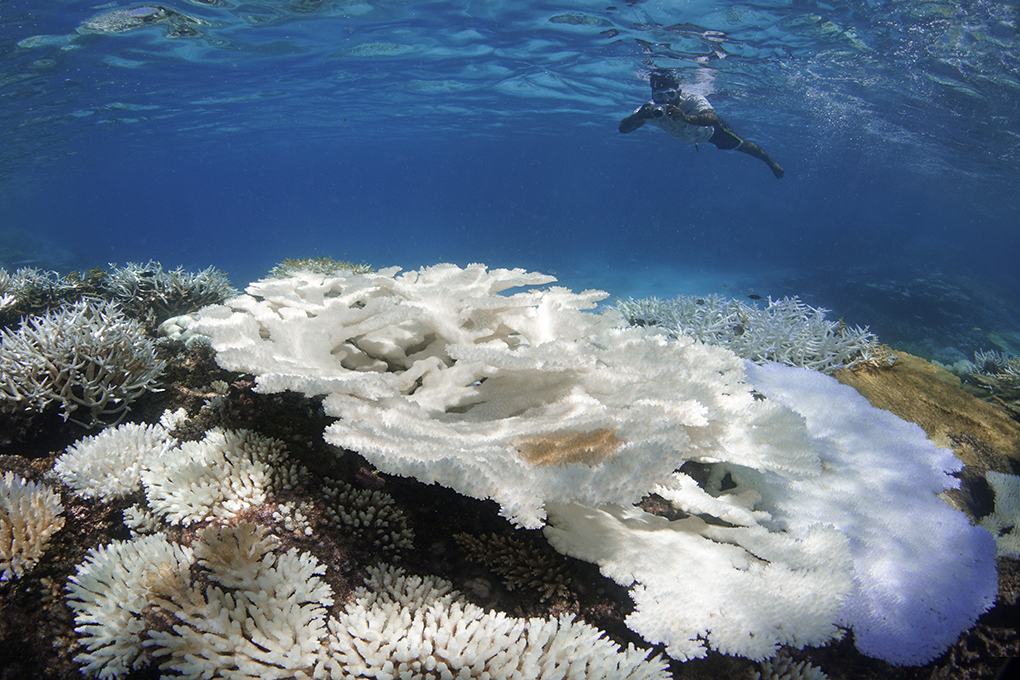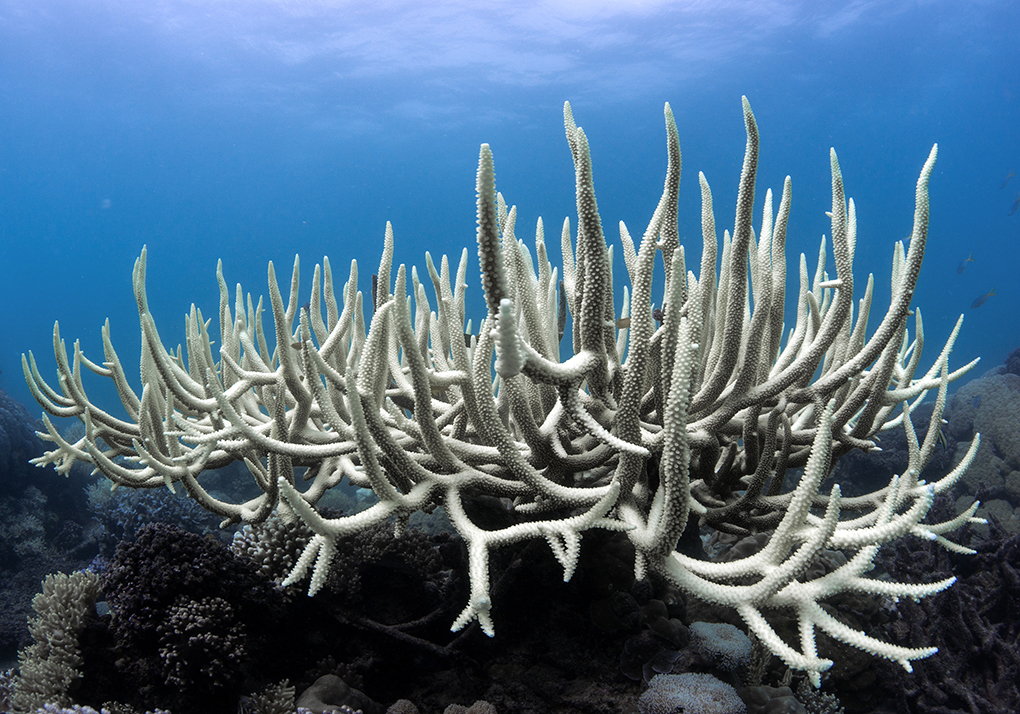
Earth has lost 14 percent of its coral reef cover in the last decade, according to the largest analysis of coral reef health ever undertaken, largely a consequence of rising sea-surface water temperatures.
Key findings:
- Large-scale coral bleaching events are the greatest disturbance to the world’s coral reefs. The 1998 event alone killed eight percent of the world’s coral, which is the equivalent of about 6,500 square kilometers of coral. The greatest impacts of this mass bleaching event were seen in the Indian Ocean, Japan, and the Caribbean, with smaller impacts observed in the Red Sea, The Gulf, the northern Pacific in Hawaii and the Caroline Islands, and the southern Pacific in Samoa and New Caledonia.
- Between 2009 and 2018, the world lost about 14 percent of the coral on its coral reefs, which equates to around 11,700 square kilometers of coral, more than all the living coral in Australia.
- Reef algae, which grows during periods of stress, has increased by 20 percent over the past decade.
- Prior to this, on average there was twice as much coral on the world’s reefs as algae.
- Coral reefs in East Asia’s Coral Triangle, which is the center of coral reef biodiversity and accounts for more than 30 percent of the world’s reefs, have been less impacted by rising sea surface temperatures. Despite some declines in hard coral during the last decade, on average, these reefs have more coral today than in 1983 when the first data from this region were collected.
- Almost invariably, sharp declines in coral cover corresponded with rapid increases in sea surface temperatures, indicating their vulnerability to spikes, which is a phenomenon that is likely to happen more frequently as the planet continues to warm.
The “Status of Coral Reefs of the World: 2020” report, draws on data:
- spanning 40 years
- in 73 countries
- across 12,000 sites
- collected by more than 300 scientists
- through 2 million individual observations.
Corals reefs across the world are under relentless stress from warming caused by climate change and other local pressures such as overfishing, unsustainable coastal development, and declining water quality. An irrevocable loss of coral reefs would be catastrophic.
Although reefs cover only 0.2 percent of the ocean floor they are home to at least a quarter of all marine species, providing critical habitat and a fundamental source of protein, as well as life-saving medicines. It is estimated that hundreds of millions of people around the world depend on them for food, jobs, and protection from storms and erosion.

Some Good News
However, the report also found that many of the world’s coral reefs remain resilient and can recover if conditions allow, providing hope for the long-term health of coral reefs if immediate steps are taken to stabilize emissions to curb future warming.
Dr. Paul Hardisty, CEO of the Australian Institute of Marine Science: “This study is the most detailed analysis to date on the state of the world’s coral reefs, and the news is mixed. There are clearly unsettling trends toward coral loss, and we can expect these to continue as warming persists. Despite this, some reefs have shown a remarkable ability to bounce back, which offers hope for the future recovery of degraded reefs. A clear message from the study is that climate change is the biggest threat to the world’s reefs, and we must all do our part by urgently curbing global greenhouse gas emissions and mitigating local pressures.”
The analysis which examined 10 coral reef-bearing regions around the world(1) showed that coral bleaching events caused by elevated sea surface temperatures (SSTs) were the main driver of coral loss, including an acute event in 1998 that is estimated to have killed eight percent of the world’s corals, which, to put this in context, is more than all the coral that is currently living on reefs in the Caribbean or the Red Sea and Gulf of Aden regions. The longer-term decline seen during the last decade coincided with persistent elevated SSTs.
The analysis investigates changes in the cover of both live hard coral and algae. Live hard coral cover is a scientifically based indicator of coral reef health, while increases in algae are a widely accepted signal of stress to reefs. Since 1978, when the first data used in the report were collected, there has been a 9 percent decline in the amount of hard coral worldwide. Between 2010 and 2019, the amount of algae has increased by 20 percent, corresponding with declines in hard coral cover. This progressive transition from coral to algae-dominated reef communities reduces the complex habitat that is essential to support high levels of biodiversity.
The report also highlighted that although during the last decade the interval between mass coral bleaching events has been insufficient to allow coral reefs to fully recover, some recovery was observed in 2019 with coral reefs regaining 2% of the coral cover. This indicates that coral reefs are still resilient and if pressures on these critical ecosystems ease, then they have the capacity to recover, potentially within a decade, to the healthy, flourishing reefs that were prevalent pre-1998.
Inger Andersen, Executive Director of the UN Environment Programme (UNEP), which provided financial, technical, and communication support to the report: “Since 2009 we have lost more coral, worldwide, than all the living coral in Australia. We are running out of time: we can reverse losses, but we have to act now. At the upcoming climate conference in Glasgow and biodiversity conference in Kunming, decision-makers have an opportunity to show leadership and save our reefs, but only if they are willing to take bold steps. We must not leave future generations to inherit a world without coral.”
- Australia, Caribbean, Brazil, East Asian Seas, Eastern Tropical Pacific, Pacific, South Asia, Western Indian Ocean, Red Sea and Gulf of Aden, and the ROPME Sea Area.
CREDITS
Global Coral Reef Monitoring Network (GCRMN)
Download reports: Global Coral Reef Monitoring Network (GCRMN)
https://gcrmn.net/2020-report/





